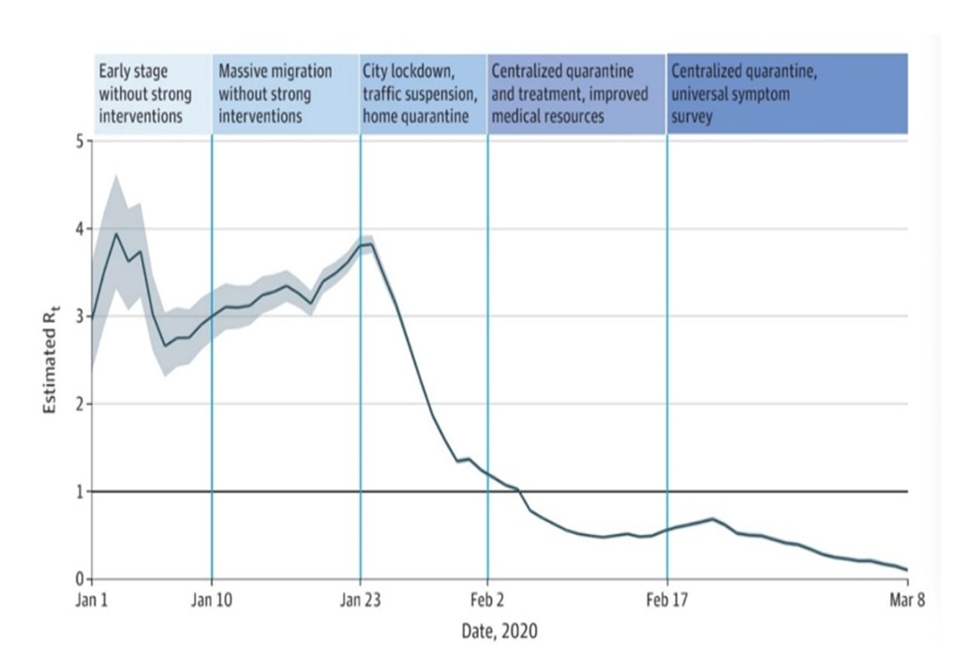On May 20th 2020 Fulbright University Vietnam hosted Xihong Lin, Professor of Biostatistics at Harvard T.H. Chan School of Public Health, as she presented her recent findings and lessons learned from COVID-19 and the response in Wuhan Province, China, the epicenter of the pandemic, as well as data from the US and Europe.
This talk is part of Fulbright’s ongoing COVID-19 talk series striving to understand this virus and its implications on the future of our societies, gathering experts from around the world to examine the multi-faceted impact of COVID on areas ranging from public health, to the economy, public policy, education, and business. The talk was hosted by TMG Group CEO and Fulbright University Vietnam Governing Board member Tran Trong Kien.
Professor Lin studied COVID-19 in the city of Wuhan, looking at the transmission patterns of the disease and the response from city authorities. Her research received worldwide attention as it constituted some of the earliest and most rigorous efforts to comprehend the virus. She strived to answer the question: what can we learn from the data? What have been effective intervention strategies? What are the risk factors affecting the spread?
“It’s important to let the data speak and develop evidence-based strategies. Wuhan’s experience helps us not start from zero,” says Professor Lin.
From social distancing to centralized quarantine
Professor Lin first discussed the effectiveness of various measures, comparing among others the reproduction values or R values. R values are the average number of new infected per contagious individuals and is a way of rating a disease’s ability to spread. In Wuhan, the implementation of social distancing through citywide lockdowns, suspension of traffic, and home quarantine on January 23rd greatly reduced the spread of the virus, dropping from an R value of 3-4 to 1.
“An R value of 3-4 demonstrates a very infectious disease, and social distancing demonstrated its effectiveness by bringing this value close to 1. But to truly consider an epidemic under control, this value has to drop as close to 0 as possible. For this, social distancing is not enough,” explained the statistician.
Indeed, household members tend to fall ill together. When living with a sick household member, the risk of infection rises as high as 50%. To reduce the number of new infections, authorities needed to control the source of infection, which meant protecting family members and loved ones by isolating infected cases through centralized quarantine centers, triaging by likelihood of infection (See graph below).

Household and congregated place transmission is common and needs to be blocked.
“Social distancing helped flatten the curve by reducing between-household spread, and centralized quarantine slowed in-household infections, therefore bending the curve to finally stop the epidemic,” says Professor Lin.
A societal effort to beat the virus – and return to normal
The statistician also urges us to pay special attention to five vulnerable groups. As shown above, family members and close contacts of infected cases are at highest risk of infection. But health workers as well as essential workers also bear the heaviest burden with disproportionate infection rates. The elderly also demonstrate a higher vulnerability to the virus. In Massachusetts, data shows the average age of infected cases is 53 years old, affecting those over 80 years old the most. Finally, low-income households also deserve special attention, suffering from typically higher density homes and poor housing conditions making social distancing difficult. Individuals in this socio-economic group also feel a stronger pressure to go back to work.
Xihong Lin outlined the 6 pillars needed to control the epidemic: mask wearing, social distancing, widespread testing, contact tracing, isolation and quarantine, and of course treating infected patients. All these elements constitute barriers to the spread of the virus at various scales, requiring the collaboration of individuals and institutions at all levels of society to study, contain, supply, and contribute to overcoming the crisis. “At all stakeholder levels, from international organizations, to governments, academia, business and citizens, it is important to work together as a team to curb the spread of the virus,” says the professor.
Reopening international borders
Vaccines remain beyond the immediate horizons, and immunity has only reached up to 20% in New York, far from herd immunity levels which begin at 50 to 60%. Those herd immunity levels also represent a cost in lives of more vulnerable members of society “that most countries are not willing to pay,” says Professor Lin. Yet as the virus gradually becomes contained, countries around the world are considering the loosening of social distancing measures as well as the reopening of international borders. Wuhan province waited 2 weeks without community spreading before reopening. But in the US, some states have already reopened despite an R value still above 1. For Dr. Lin, it is to be expected that different states would make different decisions while keeping in mind both public health and the economy. The key to success, for our expert, is multi-stage, evidence-based strategies.

Updated analysis from Wuhan statistics until March 8
“Start small, and slowly open more. Each phase of reopening has to go hand in hand with developing strategies relevant to each of the six pillars. Before the development of a vaccine, those previously mentioned prevention measures remain critical,” says Dr. Lin. Countries will have to consider options that work best for them. Xihong Lin emphasized the case of Korea, where individuals coming into the country have to be tested and quarantined before entering the country, and are required to install a contact tracing app to control community spread and limit international risks of contagion. But other strategies can be explored. For example, data suggests Vietnam might have the testing capacity to see systematic testing as a viable option, opening international travel while limiting risks.
“There is a chance to see a surge in cases when the global economy and travel normalizes. At the same time, public awareness of the right behaviors is growing, plans and resources dedicated to monitor and contain the virus increase, which will be strong factors in preventing or limiting new surges of the virus,” Dr. Lin concludes.
- Antoine Touch
Related Articles

The Prospects for World’s Post–Covid-19 Economy

Public Lecture at Fulbright by Dean of Harvard Kennedy School

